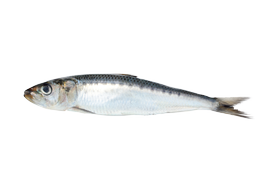
Sardines/pilchards/anchovies/sprats
For natural reasons the same fishe can have different names depending on where they are caught and eaten, not least in the case of small, oily forage fish:
Fishy facts
Pilchards and sardines are the same species of fish, but sardines live (are caught...) in warmer waters and are less than six inches long.
"Sprat" is the name applied to several species of small, oily fishes belonging to the herring family. They look like miniature sardines and are recognized by the sharp scales along the belly. Sprats are eaten in many places around the world and contain high levels of healthy, polyunsaturated fats. Products sold as having been prepared from anchovies and sardines are sometimes actually prepared from sprats.
In Scandinavia, the fish sold in tins as “anchovies” is often spiced, cured sprats. The name "anchovy" refers to the flavoring rather than the fish. Genuine anchovies are not related to sprats but the result after adding spices and storing are similar.
“Anchovy” in international recipes usually refers to the Italian version, sardeli, in oil. To keep things simple, from here on we will use only the name "anhovies":
How to cook anchovies
Anchovies are excellent for adding flavor. They add a powerful salty, umami flavor to fish dishes, minced fish, tomato sauces, meatballs, pizza, risotto etc.
Egg in all its forms is the perfect partner, especially the yolk.
Fresh anchovies are best at colder times of year.
The classic
Egg and anchovy salad on crispbread. And the Swedish dish Jansson’s Temptation – potato, onion, sprats and cream.








